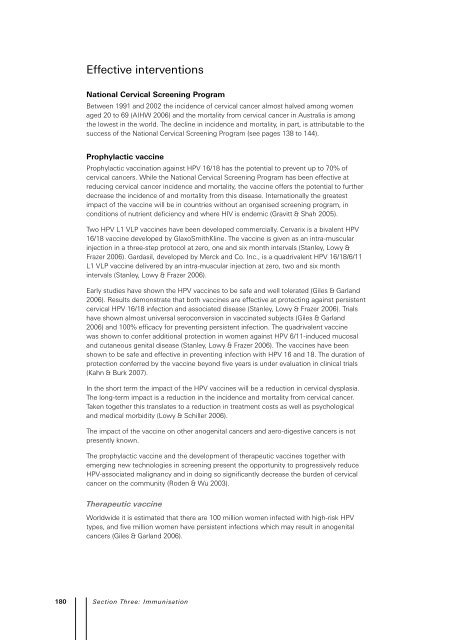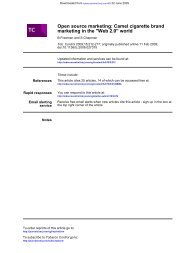National Cancer Prevention Policy - Tobacco Control Supersite
National Cancer Prevention Policy - Tobacco Control Supersite
National Cancer Prevention Policy - Tobacco Control Supersite
Create successful ePaper yourself
Turn your PDF publications into a flip-book with our unique Google optimized e-Paper software.
Effective interventions<br />
<strong>National</strong> Cervical Screening Program<br />
Between 1991 and 2002 the incidence of cervical cancer almost halved among women<br />
aged 20 to 69 (AIHW 2006) and the mortality from cervical cancer in Australia is among<br />
the lowest in the world. The decline in incidence and mortality, in part, is attributable to the<br />
success of the <strong>National</strong> Cervical Screening Program (see pages 138 to 144).<br />
Prophylactic vaccine<br />
Prophylactic vaccination against HPV 16/18 has the potential to prevent up to 70% of<br />
cervical cancers. While the <strong>National</strong> Cervical Screening Program has been effective at<br />
reducing cervical cancer incidence and mortality, the vaccine offers the potential to further<br />
decrease the incidence of and mortality from this disease. Internationally the greatest<br />
impact of the vaccine will be in countries without an organised screening program, in<br />
conditions of nutrient deficiency and where HIV is endemic (Gravitt & Shah 2005).<br />
Two HPV L1 VLP vaccines have been developed commercially. Cervarix is a bivalent HPV<br />
16/18 vaccine developed by GlaxoSmithKline. The vaccine is given as an intra-muscular<br />
injection in a three-step protocol at zero, one and six month intervals (Stanley, Lowy &<br />
Frazer 2006). Gardasil, developed by Merck and Co. Inc., is a quadrivalent HPV 16/18/6/11<br />
L1 VLP vaccine delivered by an intra-muscular injection at zero, two and six month<br />
intervals (Stanley, Lowy & Frazer 2006).<br />
Early studies have shown the HPV vaccines to be safe and well tolerated (Giles & Garland<br />
2006). Results demonstrate that both vaccines are effective at protecting against persistent<br />
cervical HPV 16/18 infection and associated disease (Stanley, Lowy & Frazer 2006). Trials<br />
have shown almost universal seroconversion in vaccinated subjects (Giles & Garland<br />
2006) and 100% efficacy for preventing persistent infection. The quadrivalent vaccine<br />
was shown to confer additional protection in women against HPV 6/11-induced mucosal<br />
and cutaneous genital disease (Stanley, Lowy & Frazer 2006). The vaccines have been<br />
shown to be safe and effective in preventing infection with HPV 16 and 18. The duration of<br />
protection conferred by the vaccine beyond five years is under evaluation in clinical trials<br />
(Kahn & Burk 2007).<br />
In the short term the impact of the HPV vaccines will be a reduction in cervical dysplasia.<br />
The long-term impact is a reduction in the incidence and mortality from cervical cancer.<br />
Taken together this translates to a reduction in treatment costs as well as psychological<br />
and medical morbidity (Lowy & Schiller 2006).<br />
The impact of the vaccine on other anogenital cancers and aero-digestive cancers is not<br />
presently known.<br />
The prophylactic vaccine and the development of therapeutic vaccines together with<br />
emerging new technologies in screening present the opportunity to progressively reduce<br />
HPV-associated malignancy and in doing so significantly decrease the burden of cervical<br />
cancer on the community (Roden & Wu 2003).<br />
Therapeutic vaccine<br />
Worldwide it is estimated that there are 100 million women infected with high-risk HPV<br />
types, and five million women have persistent infections which may result in anogenital<br />
cancers (Giles & Garland 2006).<br />
1 0 Section Three: Immunisation




